|
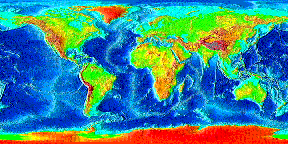 |
![]()
Aristotle
The ancient Greeks thought about how objects move and forces that act upon them. Aristotle (384-322 BC) was one of the more famous Greek philosophers. One outcome of Aristotelian thinking is that an arrow, when shot ("violent motion"), has a force acting upon it until it comes to its "natural state" (at rest). Clearly the shooter of the arrow can't exert a force on it once the it leaves their bow, unless one considers forces acting at a distance, such as gravity and electrical forces. Even today many people would argue that an arrow in motion must have a force acting on it that causes it to move (but not to slow down), and that the force is used up as the arrow slows down.
Galileo
The Italian Galileo Galilei thought differently... and paid the price for it! For one, he advocated for the Copernican view that the sun was at the center of the solar system, which went against church dogma. He was tried for this view and forced to renounce his discoveries.
One of Galileo's discoveries involved balls rolling down ramps, along level tracks, and up ramps.

A ball rolling down a ramp would roll on the level and up another ramp, coming to more or less the same height as it started (he recognized that friction prevented it from reaching the same height).
Galileo found that he could make the end ramp longer and less steep and the ball would return to the same height regardless. He reasoned that an end ramp that was almost level and quite long would result in the ball rolling on, seemingly forever.
This property of the ball-- to roll on forever without changing speed along the level track-- he called inertia.
Newton
In 1642, when Galileo died, Isaac Newton was born in England. By the time Newton was 23 he had developed his three laws of motion. His first law included Galileo's findings about inertia for moving objects:
Every object continues in its state of rest, or of uniform motion in a straight line, unless it is compelled to change that state by forces impressed upon it.
Newton's first law allowed for a state where an object was at rest. It also very carefully described uniform motion to be in a straight line, without change in speed.
![]() How does one change the state of uniform motion, or of rest, of an object?
How does one change the state of uniform motion, or of rest, of an object?
![]() Apply a force!
Apply a force!
So INERTIA tells us something about an object's tendency to stay in the same state (say, Nebraska, for example). It could be at rest, or moving at a constant velocity (speed and direction).
![]() What are some important characteristics controlling inertia?
What are some important characteristics controlling inertia?
Aristotle's arrow does have a net force acting on it, even after leaving the archer's bow. Air resistance causes it to slow down.
It is useful to think of the forces acting on the arrow in terms of components. Air resistance (drag) acts in the horizontal direction, opposite the horizontal direction of travel of the arrow (to the right, below).
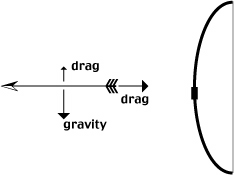
{The vertical component of drag begins to act on the arrow only after the arrow begins to fall. The faster the arrow falls, the greater the drag, so the upwards pointing drag arrow (above) grows over time.}
![]() Does the horizontal drag force change over time? Does the gravity component of force? can the vertical drag arrow grow larger (greater) in size than the gravity arrow?
Does the horizontal drag force change over time? Does the gravity component of force? can the vertical drag arrow grow larger (greater) in size than the gravity arrow?
It is possible to have two forces acting on an object with no resulting net force. Think of equal strength forces acting in opposite directions on an object. So forces add together like vectors: arrows whose length shows strength and whose direction shows, well, direction!
One can also arrange to have two forces that add together or subtract, but result in a non-zero net force acting on an object. This will change that object's state: if it is moving, its motion will change (speed, direction), if it is still, it will begin moving.
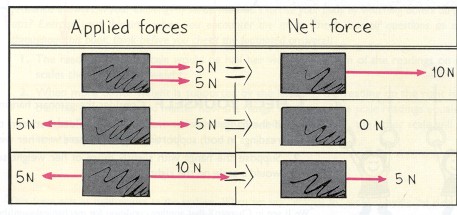
![]() What would the vectors (arrows?) representing horizontal forces on our archer's arrow look like through the arrow's launch and flight? Would the net horizontal force on the arrow be constant throughout?
What would the vectors (arrows?) representing horizontal forces on our archer's arrow look like through the arrow's launch and flight? Would the net horizontal force on the arrow be constant throughout?
As stated above, it is possible to have two forces acting on an object with no resulting force. The arrows representing the forces are equal in length and opposite in direction. Or there are no forces acting (in a direction) at all! We represent this by the symbols:
SF = 0
The "S" means "sum of" and F represents force. This says that the sum of forces is zero. In writing this we usually refer to forces in the same straight line (e.g. horizontal, or vertical). To make this more explicit, we put a subscript on the F to denote the direction we refer to (say "h" for horizontal):
SFh = 0
This condition is known as mechanical equilibrium.
An object in mechanical equilibrium won't change its state, be that resting or moving at a constant velocity.
Things that are moving
An object in constant motion is also in equilibrium.
Equilibrium is a state of no change.
![]() When is the archer's arrow in mechanical equilibrium? When is it not?
When is the archer's arrow in mechanical equilibrium? When is it not?
If an object is moving at a constant velocity (in equilibrium) then either no forces are exerted on it, or all forces (in a given line) add to zero. Here's an example.
![]()
For now, let's confine ourselves to motion in a straight line, or one-dimensional motion. The system we observe is some object in motion. We wish to:
- describe that object's motion as completely as possible.
- use descriptive characteristics (variables) to do so.
- we already know a little about mass
- we think we know about forces, though there's more to come.
- what are some other variables useful for describing motion?
Let's say our object in motion is the instructor's private jet (I wish...), taking him home after a hard day of teaching. How do we describe the instructor's position at a given time after leaving UO?
Distances & displacements or, "where's Crow, Oregon?"
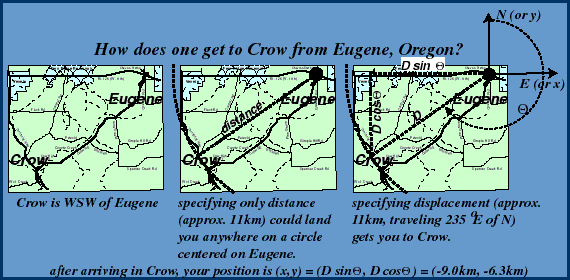
Speed-- distance (traveled) over time (which wounds all heels?).

We can test our hypothetical relationship between speed, distance and time by making, matching and interpreting graphs of distance vs. time.
Let's make some speed vs. time graphs (joy, o' joy!)!
In particular, graphs of:
- What can we say about the motion associated with different segments of our position-time graphs?
- Do our experiments verify the above relationship between speed, position and time?
Definition:
average speed is the distance traveled (d here) over the time elapsed, t.

A refinement of the relationship: Speed and velocity-- what's the difference?
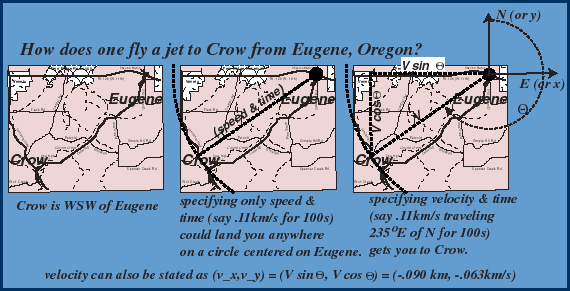
Definition:
average velocity is the change in position (Dp here) over the change in time, Dt (which is the time elapsed).

Note that f stands for final, and that i stands for initial. So that our velocity over some interval of time is the final position minus the initial position divided by the final time minus the intial time.
Let's make some velocity vs. time graphs (joy, o' joy!)!
In particular, graphs of:
![]()